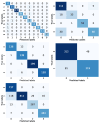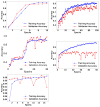MediScan: A Framework of U-Health and Prognostic AI Assessment on Medical Imaging
- PMID: 39728219
- PMCID: PMC11679653
- DOI: 10.3390/jimaging10120322
MediScan: A Framework of U-Health and Prognostic AI Assessment on Medical Imaging
Abstract
With technological advancements, remarkable progress has been made with the convergence of health sciences and Artificial Intelligence (AI). Modern health systems are proposed to ease patient diagnostics. However, the challenge is to provide AI-based precautions to patients and doctors for more accurate risk assessment. The proposed healthcare system aims to integrate patients, doctors, laboratories, pharmacies, and administrative personnel use cases and their primary functions onto a single platform. The proposed framework can also process microscopic images, CT scans, X-rays, and MRI to classify malignancy and give doctors a set of AI precautions for patient risk assessment. The proposed framework incorporates various DCNN models for identifying different forms of tumors and fractures in the human body i.e., brain, bones, lungs, kidneys, and skin, and generating precautions with the help of the Fined-Tuned Large Language Model (LLM) i.e., Generative Pretrained Transformer 4 (GPT-4). With enough training data, DCNN can learn highly representative, data-driven, hierarchical image features. The GPT-4 model is selected for generating precautions due to its explanation, reasoning, memory, and accuracy on prior medical assessments and research studies. Classification models are evaluated by classification report (i.e., Recall, Precision, F1 Score, Support, Accuracy, and Macro and Weighted Average) and confusion matrix and have shown robust performance compared to the conventional schemes.
Keywords: Large Language Model (LLM); convolutional neural networks; disease recognition; healthcare application; image processing; malignancy classification.
Conflict of interest statement
The authors have affirmed no conflicts of interest in this research study.
Figures










Similar articles
-
Generative artificial intelligence to produce high-fidelity blastocyst-stage embryo images.Hum Reprod. 2024 Jun 3;39(6):1197-1207. doi: 10.1093/humrep/deae064. Hum Reprod. 2024. PMID: 38600621 Free PMC article.
-
The Accuracy and Capability of Artificial Intelligence Solutions in Health Care Examinations and Certificates: Systematic Review and Meta-Analysis.J Med Internet Res. 2024 Nov 5;26:e56532. doi: 10.2196/56532. J Med Internet Res. 2024. PMID: 39499913 Free PMC article.
-
From jargon to clarity: Improving the readability of foot and ankle radiology reports with an artificial intelligence large language model.Foot Ankle Surg. 2024 Jun;30(4):331-337. doi: 10.1016/j.fas.2024.01.008. Epub 2024 Feb 5. Foot Ankle Surg. 2024. PMID: 38336501
-
2D medical image synthesis using transformer-based denoising diffusion probabilistic model.Phys Med Biol. 2023 May 5;68(10):105004. doi: 10.1088/1361-6560/acca5c. Phys Med Biol. 2023. PMID: 37015231 Free PMC article.
-
The Role of Large Language Models in Transforming Emergency Medicine: Scoping Review.JMIR Med Inform. 2024 May 10;12:e53787. doi: 10.2196/53787. JMIR Med Inform. 2024. PMID: 38728687 Free PMC article.
Cited by
-
GAINSeq: glaucoma pre-symptomatic detection using machine learning models driven by next-generation sequencing data.Sci Rep. 2025 Jul 2;15(1):23091. doi: 10.1038/s41598-025-04249-0. Sci Rep. 2025. PMID: 40593953 Free PMC article.
References
-
- Ahmed R., Bibi M., Syed S. Improving Heart Disease Prediction Accuracy Using a Hybrid Machine Learning Approach: A Comparative study of SVM and KNN Algorithms. Int. J. Comput. Inf. Manuf. IJCIM. 2023;3:49–54. doi: 10.54489/ijcim.v3i1.223. - DOI
-
- Syed S., Syed Z., Mahmood P., Haider S., Khan F., Syed M.T., Syed S. Application of coupling machine learning techniques and linear Bias scaling for optimizing 10-daily flow simulations, Swat River Basin. Water Pract. Technol. 2023;18:1343–1356. doi: 10.2166/wpt.2023.081. - DOI
-
- Baker S.B., Xiang W., Atkinson I. Internet of Things for Smart Healthcare: Technologies, Challenges, and Opportunities. IEEE Access. 2017;5:26521–26544. doi: 10.1109/ACCESS.2017.2775180. - DOI
-
- Tian S., Yang W., Grange J.M.L., Wang P., Huang W., Ye Z. Smart healthcare: Making medical care more intelligent. Glob. Health J. 2019;3:62–65. doi: 10.1016/j.glohj.2019.07.001. - DOI
Grants and funding
LinkOut - more resources
Full Text Sources

